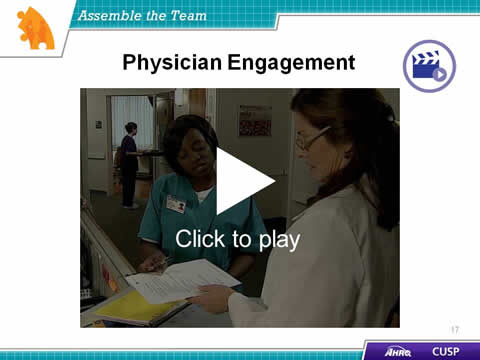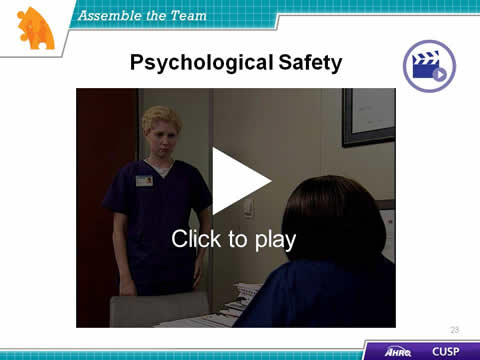Assemble the Team
CUSP Toolkit
Note: Slide content is presented below each of the images.
Contents
- Slide 1. Cover Slide.
- Slide 2. Learning Objectives.
- Slide 3. The Unit-Based CUSP Team.
- Slide 4. CUSP Team Members.
- Slide 5. Unit Team Characteristics.
- Slide 6. Team Member Characteristics.
- Slide 7. Building Your CUSP Team.
- Slide 8. CUSP Teams’ Group Processes.
- Slide 9. Team Performance.
- Slide 10. Barriers to Team Performance1.
- Slide 11. Stages of Engagement.
- Slide 12. Engage Team Members Using the 4 E’s2.
- Slide 13. Using the 4 E’s.
- Slide 14. The CUSP Project Leader's Role.
- Slide 15. Engage Physicians on the CUSP Team .
- Slide 16. The Physician Champion's Role.
- Slide 17. Physician Engagement.
- Slide 18. Engage Other CUSP Team Members.
- Slide 19. The Senior Executive's Role.
- Slide 20. The Nurse Manager's Role.
- Slide 21. The Patient Safety Coordinator/ Patient Safety Officer’s Role.
- Slide 22. Psychological Safety3.
- Slide 23. Psychological Safety.
- Slide 24. Exercise.
- Slide 25. Assemble the Team: What the Team Needs To Do.
- Slide 26. Summary.
- Slide 27. TeamSTEPPS Tools1.
- Slide 28. CUSP Tools.
- Slide 29. References.
Slide 1. Cover Slide

(CUSP Toolkit logo)
Slide 2. Learning Objectives]

- Understand the importance of your CUSP team.
- Develop a strategy to build a successful team.
- Identify characteristics of successful teams and barriers to team performance.
- Define roles and responsibilities of team members.
Slide 3. The Unit-Based CUSP Team

- Understands that patient safety culture is local.
- Composed of engaged frontline providers who take ownership of patient safety.
- Includes staff members who have different levels of experience.
- Tailored to include members based on clinical intervention.
- Meets regularly (weekly or at least monthly).
- Has adequate resources.
Slide 4. CUSP Team Members

- Nurses (including Nurse educator, Nurse manager)*.
- Physicians*.
- Senior executives*.
- Infection preventionists.
- Medical directors.
- Pharmacists.
- Respiratory therapists.
- Patient safety officers.
- Chief quality officers.
- Ancillary staff.
* Key team members
Slide 5. Unit Team Characteristics

Ven diagram showing union of CUSP and TeamSTEPPS team characteristics.
CUSP
- Has diverse local “opinion leaders” and dissenters.
- Is willing to help to spread the intervention.
(Both)
- Has strong team leadership.
- Sets defined team roles and responsibilities.
- Maintains clear values and shared vision.
- Contains mechanisms for collaboration and feedback.
TeamSTEPPS
- Develops a strong sense of collaborative trust and confidence.
- Manages and optimizes performance outcomes.
- Develops a strong sense of collective trust, team identity, and confidence.
Slide 6. Team Member Characteristics

CUSP
- Maintain positive outlook.
- Emphasize dedication to project aims.
- Focus on a broader view.
- Practice attention to detail.
Both
- Understand roles and responsibilities.
TeamSTEPPS1
- Provide quality information and feedback.
- Skillful conflict management.
- Stress reduction for the whole team through better performance.
Slide 7. Building Your CUSP Team
(vignette still)
Click to play.
Slide 8. CUSP Teams’ Group Processes

Effective Group Processes include
- Role Clarity.
- Effective Team Communication.
- Conflict Resolution.
- Education and Engagement.
- Leadership Buy-in and Support.
- Norms.
Slide 9. Team Performance
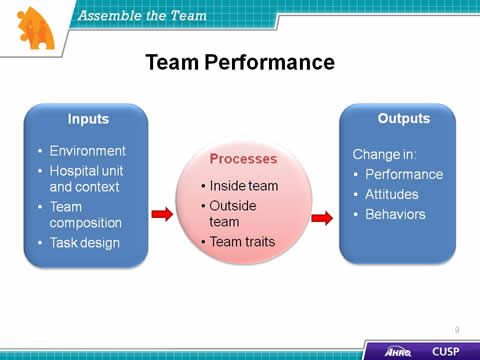
Inputs
- Environment.
- Hospital unit and context.
- Team composition.
- Task design .
Processes
- Inside team.
- Outside team.
- Team traits.
Outputs
Change in:
- Performance.
- Attitudes.
- Behaviors.
Slide 10. Barriers to Team Performance1

- Inconsistency in team membership.
- Lack of time.
- Lack of information sharing.
- Hierarchy.
- Varying communication styles.
- Presence of conflict.
- Lack of coordination and follow up.
- Misinterpretation of cues.
- Lack of role clarity.
Slide 11. Stages of Engagement

- Engagement: "To involve one’s self or become occupied; to participate fully and deeply".
- Active support of the project
- Engaged.
- Apathy.
- Aversion.
- Uninvolved.
Slide 12. Engage Team Members Using the 4 E’s2

- Engage (adaptive)-How does this make the world a better place?
- Educate (technical)-What do we need to know?
- Execute (adaptive)-What do we need to do? What can we do with our resources and culture?
- Evaluate (technical)-How do we know we improved safety?
- Senior leaders.
- Team leaders.
- Staff.
Slide 13. Using the 4 E’s
(vignette still)
Click to play.
Slide 14. The CUSP Project Leader's Role

- Encourages unit staff involvement.
- Obtains staff feedback.
- Manages documentation of CUSP activities.
- Educates staff about CUSP.
- Is a frontline provider, nurse educator, physician, or other staff member.
Slide 15. Engage Physicians on the CUSP Team

- Identify physician leaders.
- Create an understanding of this role.
- Listen to physician concerns.
- Develop plans to address concerns.
- Reward physician leaders.
- Create a vehicle for communication.
- Develop a plan for communications.
Slide 16. The Physician Champion's Role
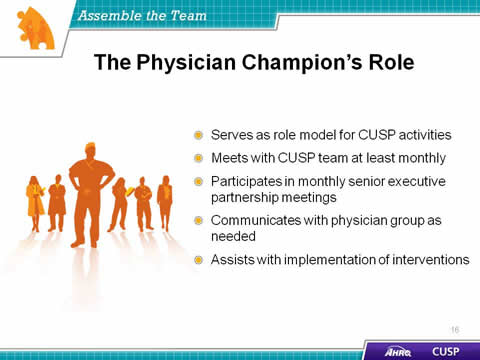
- Serves as role model for CUSP activities.
- Meets with CUSP team at least monthly.
- Participates in monthly senior executive partnership meetings.
- Communicates with physician group as needed.
- Assists with implementation of interventions.
Slide 17. Physician Engagement
(vignette still)
Click to play.
Slide 18. Engage Other CUSP Team Members
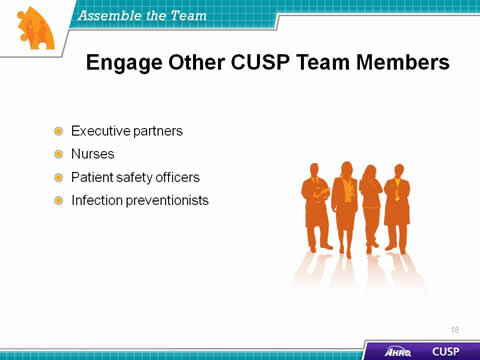
- Nurses
- Executive partners
- Infection preventionists
- Patient safety officers
Slide 19. The Senior Executive's Role
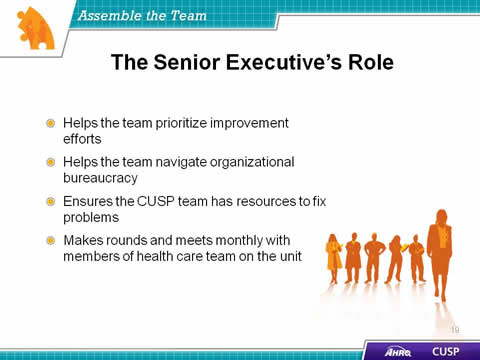
- Helps the team prioritize improvement efforts.
- Helps the team navigate organizational bureaucracy.
- Ensures the CUSP team has resources to fix problems.
- Makes rounds and meets monthly with members of health care team on the unit.
Slide 20. The Nurse Manager's Role
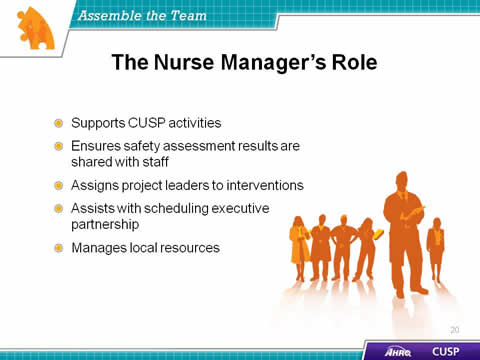
- Supports CUSP activities.
- Ensures safety assessment results are shared with staff.
- Assigns project leaders to interventions.
- Assists with scheduling executive partnership.
- Manages local resources.
Slide 21. The Patient Safety Coordinator/ Patient Safety Officer’s Role
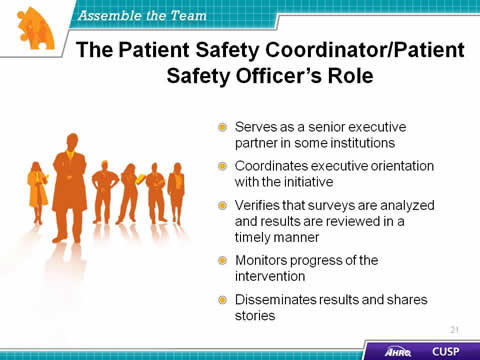
- Serves as a senior executive partner in some institutions.
- Coordinates executive orientation.
- Verifies that surveys are analyzed and results are reviewed in a timely manner.
- Monitors progress of the intervention.
- Disseminates results and shares stories.
Slide 22. Psychological Safety3
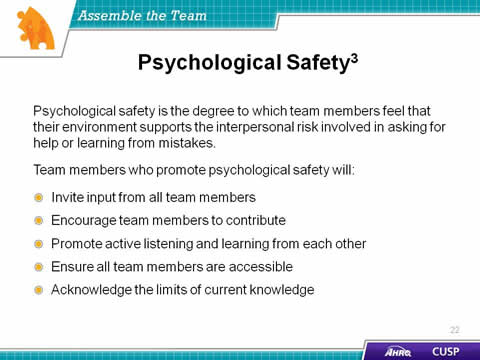
Psychological safety is the degree to which team members feel that their environment supports the interpersonal risk involved in asking for help or learning from mistakes.
Team members who promote psychological safety will:
- Invite input from all team members.
- Encourage team members to contribute.
- Promote active listening and learning from each other.
- Ensure all team members are accessible.
- Acknowledge the limits of current knowledge.
Slide 23. Psychological Safety
(vignette still)
Click to play.
Slide 24. Exercise
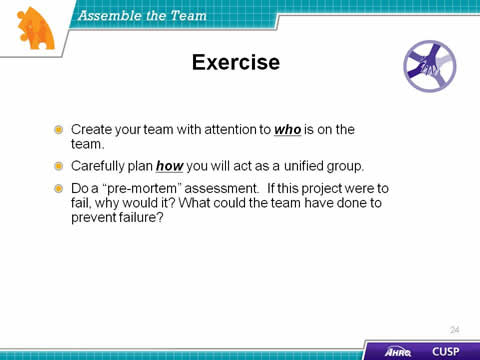
- Create your team with attention to who is on the team.
- Carefully plan how you will act as a unified group.
- Do a "pre-mortem" assessment. If this project were to fail, why would it? What could the team have done to prevent failure?
Slide 25. Assemble the Team: What the Team Needs To Do
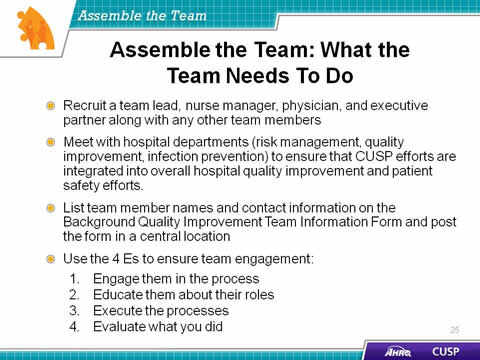
- Recruit a team lead, nurse manager, physician, and executive partner along with any other team members.
- Meet with hospital departments (risk management, quality improvement, infection prevention) to ensure that CUSP efforts are integrated into overall hospital quality improvement and patient safety efforts.
- List team member names and contact information on the Background Quality Improvement Team Information Form and post the form in a central location.
- Use the 4 Es to ensure team engagement:
- Engage them in the process.
- Educate them about their roles.
- Execute the processes.
- Evaluate what you did.
Slide 26. Summary
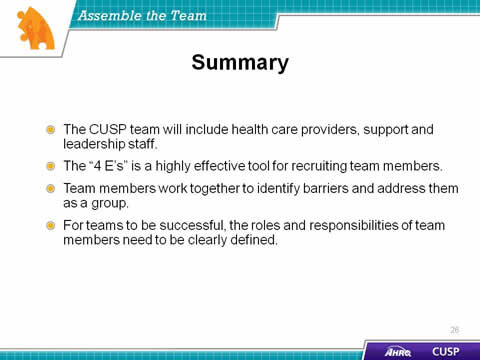
- The CUSP team will include health care providers, support and leadership staff.
- The "4 E’s" is a highly effective tool for recruiting team members.
- Team members work together to identify barriers and address them as a group.
- For teams to be successful, the roles and responsibilities of team members need to be clearly defined.
Slide 27. TeamSTEPPS Tools1
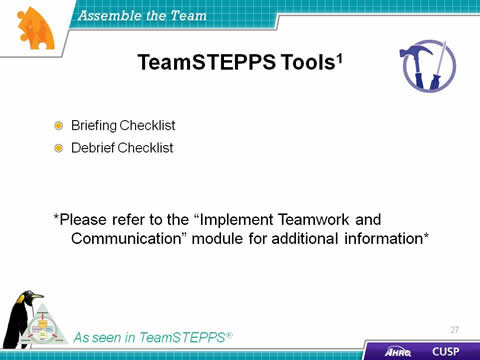
- Briefing Checklist
- Debrief Checklist
*Please refer to the Implement Teamwork and Communication module for more information.*
As seen in TeamSTEPPS®
Slide 28. CUSP Tools
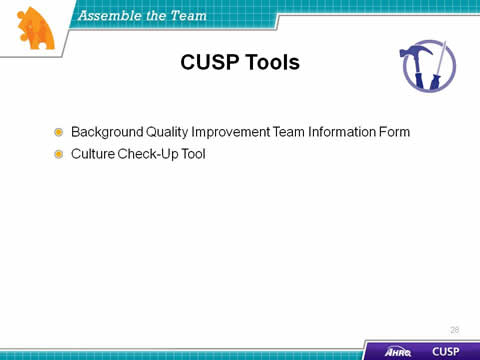
- Background Quality Improvement Team Information Form
- Culture Check-up Tool
Slide 29. References
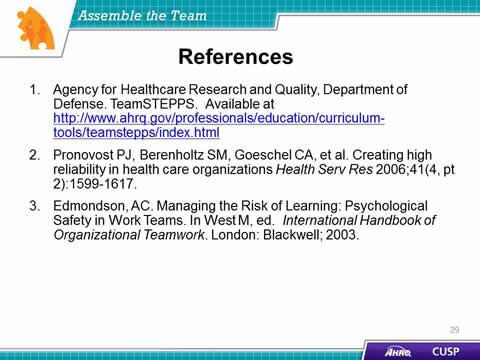
- Agency for Healthcare Research and Quality, Department of Defense. TeamSTEPPS.
- Pronovost PJ, Berenholtz SM, Goeschel CA, et al. Creating high reliability in health care organizations Health Serv Res 2006;41(4, pt 2):1599–1617.
- Edmondson, AC. Managing the Risk of Learning: Psychological Safety in Work Teams. In West M, ed. International Handbook of Organizational Teamwork. London: Blackwell; 2003.






